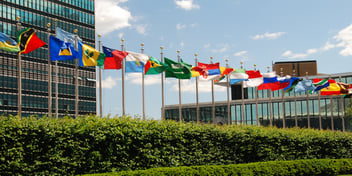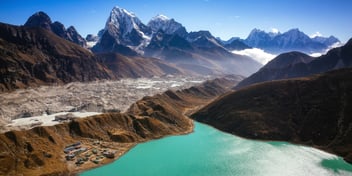YWP flags youth engagement for achieving SDG6
.png)
Youth engagement will be important to achieving Sustainable Development Goal 6 (SDG6), according to one young water professional who has created a scenario-based water supply exercise to bolster water literacy among students and inspire action.
Jacobs Senior Process Engineer and 2023 Australian Young Water Professional of the Year Chelsea Hayward has developed a youth engagement challenge as part of her participation in the International Water Association (IWA)-Grundfos Youth Action for SDG6 Fellowship.
One of 14 international young water professionals selected for the year-long fellowship, Hayward said after attending the UN Water Conference all fellows are tasked with developing a project reflective of the themes and topics raised at the event.
“The fellowship is about increasing youth presence at the UN Water Conference and making sure youth participation is a focus. There was a lot of effort put into making sure the fellows were actively participating in various sessions,” she said.
“As part of the fellowship, we were then also tasked with working on projects that followed on from the conference, and finding a way to disseminate some of the learnings. But it is also about finding a way to promote and advocate for active youth engagement in the broader water sector as we work to tackle SDG6.”
Focusing on youth engagement among high school students, Hayward said her project leans into the idea that youth are important catalysts for change in the broader community.
“One of the overall UN Water Conference themes was cooperation among stakeholders to achieve SDG6. Water industry professionals and policy makers are obvious stakeholders in contributing to that goal, but it's really important that we get the community on board.
“They are a very important stakeholder in achieving SDG6, as well. Having that active participation from the community can lead to more grassroots change, and foster a collective awareness and understanding around the value of water.
“We have seen youth rise up for action on climate change recently – youth are becoming increasingly conscientious and active participants in society and really starting to challenge some of these important issues.
“Youth absolutely play an important role in raising awareness and advocating for change and action on sustainable development. When we educate young people, they take that back to their families and friends, which can help spread awareness through the community.”
Fostering deeper understanding
While already experienced with youth outreach initiatives, Hayward said she wanted to create something different – a challenging exercise that would expose students to diverse issues, hurdles and perspectives when learning about water.
“I volunteer with Engineers Without Boarders Australia. I have been their national youth outreach coordinator for a couple of years. I decided to go with designing a youth outreach program because it made sense to leverage my experience,” she said.
“But I wanted to try something different for the types of exercises I already had experience with. I brainstormed with colleagues from AWA and other young water professionals. Having those conversations with others in the sector helped a lot.
“A little idea then sparked into creating a challenge. Participants have to look at a fictional water supply system, focusing on different water users, including homes, businesses and different industries, and thinking about environmental and cultural water, as well.
“They then have various different water sources available, too, which have different volumes and qualities available.”
Hayward recently launched the exercise at a high school in Sydney – given one hour, Hayward decided to test out one of the more challenging scenarios with the students.
“We went with one of the difficult scenarios – a drought scenario. There wasn't enough surface water, so they had to think about where else they could get their water from, whether that be desalination or groundwater,” she said.
“But they also had to think about whether or not to introduce water restrictions. It required the students to have discussions and make group decisions.
“None of the groups came up with the same solution. We then discussed why they made those decisions, and linked the exercise back to real-world examples.”
Aiming to place the students in the shoes of water managers, the task also involved thinking through the perspectives of different water users.
“I created these persona cards for the different types of water users. The cards included what each persona uses water for and what would happen if they didn't get enough water. This encourages students to think through various perspectives,” Hayward said.
“Teenage students are renowned for being hard to engage. But the response was very positive. They were debating and discussing important topics and having fun doing it. And that’s pretty much the best outcome.”
Broader impact
While the exercise is designed to expose students to a raft of different complexities when it comes to water provision, Hayward said it also offers opportunities to discuss important issues in water management more broadly.
“Targeting Australian youth in metropolitan Australia, if you ask someone if water is valuable to our lives, the answer is: of course, yes,” she said.
“But it’s not something people think about actively everyday, unless we are in a drought period. Outside of the industry, people don’t talk that much about water unless there is too much or not enough of it.
“I wanted to raise awareness around SDG6 among young people and inspire them to become agents of change within their community. Young people can be drivers towards communities taking action on SDG6
“There are areas of Australia where access to water is a big issue. I wanted to create that understanding of the value of water across all aspects of our lives.”
Furthermore, Hayward said she hopes the exercise helps students to become more aware of the types of career paths available within the water sector – and view water as a rewarding career path.
“A lot of people never planned to have a career in water. I wanted the exercise to help increase the profile of careers in water and present the sector as a purpose-driven career option.”
Recently returning from a trip to Denmark, Hayward attended the Grundfos headquarters with the other fellows to present their projects.
“We’ve been working on these projects, and they are feeding into a joint IWA/Grundfos publication. It’s a collection of case studies and insights from our work,” she said.
“We had some discussions, reflecting back on the UN Water Conference and thinking about what’s next. The publication will be launched at the IWA Water and Development Congress in Kigali in December.’


